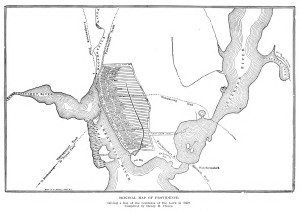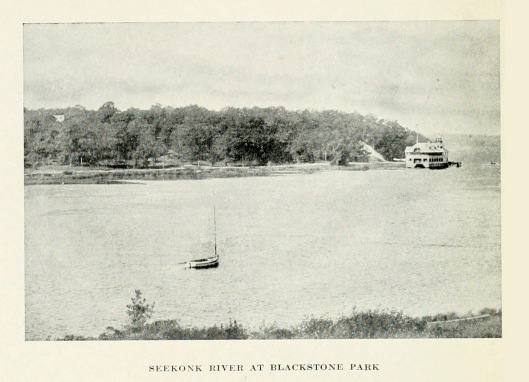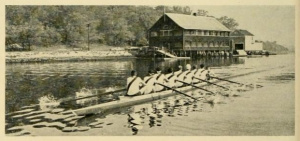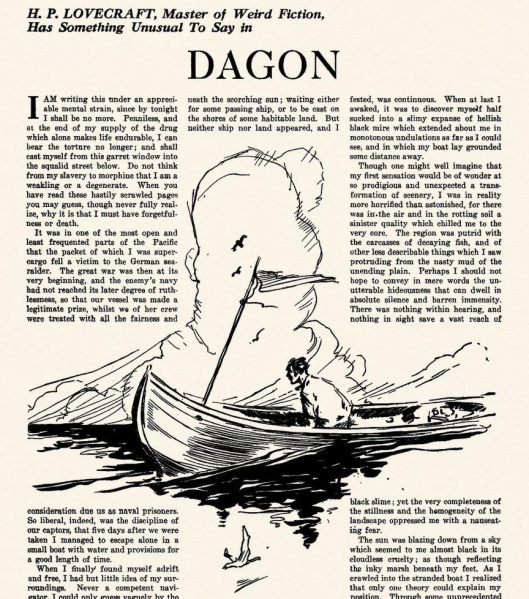H. P. Lovecraft was once something of a waterman on the Seekonk River, seen above in a Whitman Bailey drawing made on the Poe-haunted west shore at Blackstone Park…
“I used to row considerably on the Seekonk … Often I would land on one or both of the Twin Islands — for islands (associated with remote secrets, pirate treasure, and all that) always fascinated me.” — Lovecraft letter to Rimel, April 1934.
The islands are locally known as Cupcake Island and Pancake Island, indicating their respective shapes. Though these may be modern post-1945 names. There appears to be no vintage photograph, sketch or postcard of them, available online. But one can see them on this map…
They can also be seen on some of the earliest maps of Providence, c. 1650…
From where and how would the young Lovecraft row? One imagines that, once old and strong enough to row alone on a large river, he might have been allowed to take out a row-boat from the Boat Club boathouse (opened c. 1884). The name of his grandfather probably still had some sway with Club, and he might have avoided the sort of hire-fee he could have had to pay at Red Bridge. The boathouse can be seen here…
The residential house seen through the trees is one in Angell St., so that indicates Lovecraft’s proximity to the boathouse. The boathouse had an interesting gothic look from a certain angle…
Lovecraft must have been no puny stripling at this time, for the Seekonk could be a dangerous river and the city Report noted that a rescue crew patrolled the river on Sundays and holidays circa 1912. Today the Brown University men’s rowing team notes that…
The Seekonk is known for its difficult rowing conditions, particularly heavy wind and waves, as well as a strong current.
Thus perhaps we can assume a Lovecraft who was aged 14 or 15, circa 1904 or 1905? Lovecraft might not have encountered the Brown rowing team’s twice-daily training (they apparently had another boat-house nearby). As evidenced by the statement… “The Brown Alumni Monthly has been for years in favor of the resumption of rowing at Brown” (1915), implying that the team might have been moribund for a number of years prior to 1915.
In his row-boat experience, and the island encounters amid the shifting sediments, do we glimpse the personal roots of his famous story “Dagon” (July 1917)? His nightmare of the Seekonk River draining away to reveal primal ooze was recounted in a letter of May 1920 (“the river-bed was fully exposed — only the deep channel filled with water like a serpentine stream of death flowing through a pestilential plain in Tartarus”), but Lovecraft called this a “typical dream” — thus there may have been similar pre-“Dagon” dreams. Indeed we know there were, as he later wrote of “Dagon” that… “I dreamed that whole hideous crawl, and can yet feel the ooze sucking me down!” If this latter dream was of the drained Seekonk or not, must now remain unknown. But the likelihood is that it was.
The flow of the river was probably faster then, because its main flow was in a far narrower and shallower navigation channel of 12 feet, this being “the deep channel” referred to by Lovecraft. Only in 1927 did a U.S military dredging project dredge a longer and deeper… “3.4-mile-long channel, 16 feet deep” all the way from East Providence to Pawtucket. “The channel is 150 feet wide from the Red Bridge to an area opposite Goose Point where it widens further to 230 feet.” (U.S. Army, Seekonk River Navigation Project).
His ‘considerable’ rowing experience on the Seekonk may also help explain his extreme delight in the header illustration he had in Weird Tales, for “Dagon”, since he would then see in it not only an illustration of the story, but also a reflection of his own experience of rowing on the Seekonk…
Presumably such things were cast off along with his bicycle, which he ceased using altogether in the summer of 1913, long past the point when he was expected by local convention to shed such boyish activities. As his family descended into poverty, he may anyway have lacked the hire-fee for such a boat.
See also: the mysterious river island in “Dreams in the Witch House”…
She had told Judge Hathorne of lines and curves that could be made to point out directions leading through the walls of space to other spaces beyond, and had implied that such lines and curves were frequently used at certain midnight meetings in the dark valley of the white stone beyond Meadow Hill and on the unpeopled island in the river. […] He [later] rowed out twice to the ill-regarded island in the river, and made a sketch of the singular angles described by the moss-grown rows of grey standing stones whose origin was so obscure and immemorial.











Pingback: Friday ‘picture postals’ from Lovecraft: the dockside | Tentaclii
Pingback: Lovecraft on a bicycle | Tentaclii
Pingback: Lovecraft on a bicycle | Tentaclii
Pingback: Lovecraft on a bicycle | Tentaclii
Pingback: Photo of the Twin Islands | Tentaclii